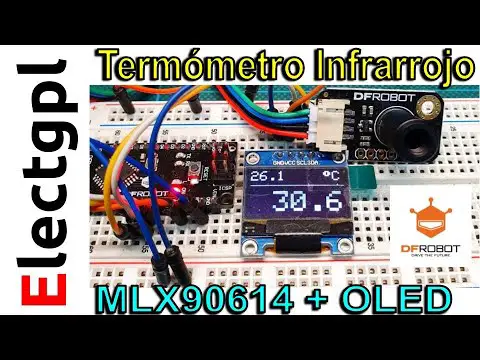The mlx90614: the perfect non-contact infrared thermometer for your Arduino projects
Can you imagine being able to measure the temperature of objects without the need for contact? Well now it is possible with the mlx90614! If you are passionate about Arduino projects and want to take your skills to the next level, this non-contact infrared thermometer is perfect for you. In this article, we will discover all the wonders that the mlx90614 can offer you and how you can incorporate it into your creations. Get ready to enter a new world of possibilities with this incredible temperature sensor!
How the MLX90614 Sensor Works: A Complete Guide
The MLX90614 sensor is a device that allows non-contact temperature measurement using infrared technology. In this complete guide, we will explain how this sensor works and how you can use it in your projects.
To better understand the operation of the MLX90614 sensor, it is important to understand that it is composed of an infrared detector and a signal processing circuit. The infrared detector is responsible for capturing the thermal radiation emitted by objects and converting it into an electrical signal. The signal processing circuitry is then responsible for converting this signal into an accurate temperature reading.
One of the most notable features of the MLX90614 sensor is that it has two built-in temperature sensors: one to measure the ambient temperature and another to measure the temperature of a specific object. This allows more precise measurements to be obtained and eliminates possible errors caused by the influence of ambient temperature.
The MLX90614 sensor uses infrared technology to measure thermal radiation from objects. This thermal radiation is emitted by all objects at a specific frequency, which is related to their temperature. The MLX90614 sensor is capable of detecting this radiation and converting it into an electrical signal, which is then processed to obtain the temperature reading.
To use the MLX90614 sensor in your projects, you need to follow a few basic steps. First of all, you must connect the sensor to your microcontroller or development board using the corresponding pins. Next, you must configure the sensor using specific commands to set the desired measurement parameters.
Once set up, you can begin taking temperature measurements using the MLX90614 sensor. To do this, you simply have to send an activation signal to the sensor and wait for it to perform the measurement. Afterwards, you can read the temperature reading through the previously established communication interface.
Importantly, the MLX90614 sensor offers an accuracy of ±0.5°C over a temperature range of -40°C to +125°C. In addition, it has a wide field of view, which makes it ideal for applications where the temperature of several objects needs to be measured at the same time.
The fascinating operation of the non-contact infrared thermometer
The non-contact infrared thermometer is a fascinating tool that allows you to measure the temperature of an object or person without the need for physical contact. Its operation is based on infrared radiation detection technology, which allows it to capture the thermal energy emitted by the object in question.
This type of thermometer uses a sensor that converts infrared radiation into an electrical signal. Through an analysis process, the electrical signal is converted into a temperature reading, which is displayed on the device's screen.
One of the most notable advantages of this type of thermometer is its ability to measure temperature from a distance, which is especially useful in situations where it is required to maintain a certain safety distance, such as in the case of contagious diseases.
Plus, the non-contact infrared thermometer is fast and accurate, delivering results in seconds. This makes it an ideal tool for use in medical, industrial and home environments.
It is important to keep in mind that although these types of thermometers are very useful, there are certain factors that can affect their accuracy. For example, the presence of dust, smoke or steam in the air can interfere with the temperature reading. In addition, the distance at which the measurement is carried out can also influence the results obtained.
The operation and applications of the Arduino infrared sensor
The infrared sensor is a fundamental component in the world of electronics and programming, and its integration with Arduino has allowed endless applications in various fields. In this article, we will explore how this sensor works and the different ways it can be used.
Operation:
The infrared sensor is based on the detection of infrared radiation emitted by objects or heat sources. These sensors are made up of an infrared emitter and receiver. The emitter emits an infrared signal and the receiver receives it and converts it into an electrical signal. The intensity of the received signal depends on the distance and material of the detected object.
On Arduino, the infrared sensor is connected through the digital pins. The emitter connects to an output pin and the receiver to an input pin. Using the appropriate library, the pins can be configured to send and receive signals and thus obtain the necessary information.
Applications:
The Arduino infrared sensor has a wide range of applications in different areas. Some of the most common applications are the following:
1. Object detection: The infrared sensor can be used to detect the presence or absence of objects within a certain distance range. This allows the automation of security systems, such as automatic doors, alarm systems or even obstacle avoidance robots.
2. Line tracking: By using infrared sensors, it is possible to program a robot to follow a line drawn on the ground. This is achieved by detecting changes in surface reflectivity.
3. Remote control: Infrared sensors are also used in remote control devices, such as remote controls for televisions or air conditioners. These sensors are capable of receiving the infrared signals emitted by these controls and transmitting them to the corresponding device.
4. Control systems: The infrared sensor can be used to control different devices based on the proximity of an object or person. For example, an alarm can be programmed to go off when someone gets too close to a restricted area.
5. Temperature measurement: Some infrared sensors have the ability to measure the temperature of an object without the need
Dare to measure the temperature without touching anything with the mlx90614! This infrared thermometer is the best friend of your Arduino projects. Forget getting closer to the person or object you want to measure, just point and bang! You have the temperature instantly.
Imagine the surprise on your friends' faces when you tell them that you can measure the temperature without touching anything. They are sure to have their mouths open and look at you as if you were a technology wizard.
Plus, the mlx90614 is super accurate, so you can trust its measurements. You will no longer have to worry about those thermometers that go out of calibration or give you wrong results. With this small device, you will have the temperature under control in any project you propose.
And don't worry about installation, because it's a piece of cake. With Arduino, you always have at your disposal a community of makers willing to help you with everything you need. So there are no excuses, dare to try the mlx90614 and become the king of non-contact measurements.
Don't stay in the past, join the non-contact infrared thermometer revolution! With the mlx90614, your Arduino projects will be more precise and amazing than ever. Don't wait any longer and give a touch of technology to your experiments!




Post Comment